International Economics Assignment 1 Solution - RMIT University
VerifiedAdded on 2023/04/07
|7
|893
|361
Homework Assignment
AI Summary
This International Economics assignment solution analyzes trade openness for Italy and Sweden from 2003-2015, calculating trade openness percentages and comparing their trends, including the impact of the 2008 financial crisis. It examines the correlation between trade openness and GDP per capita for both countries, revealing a positive relationship. The solution also explores the concepts of absolute and comparative advantage using a hypothetical scenario involving Singapore and Australia, calculating opportunity costs and constructing Production Possibility Frontiers (PPF). Finally, it determines autarky relative prices and trade scenarios under autarky, providing a comprehensive understanding of international trade principles. The assignment references relevant economic literature to support its analysis.
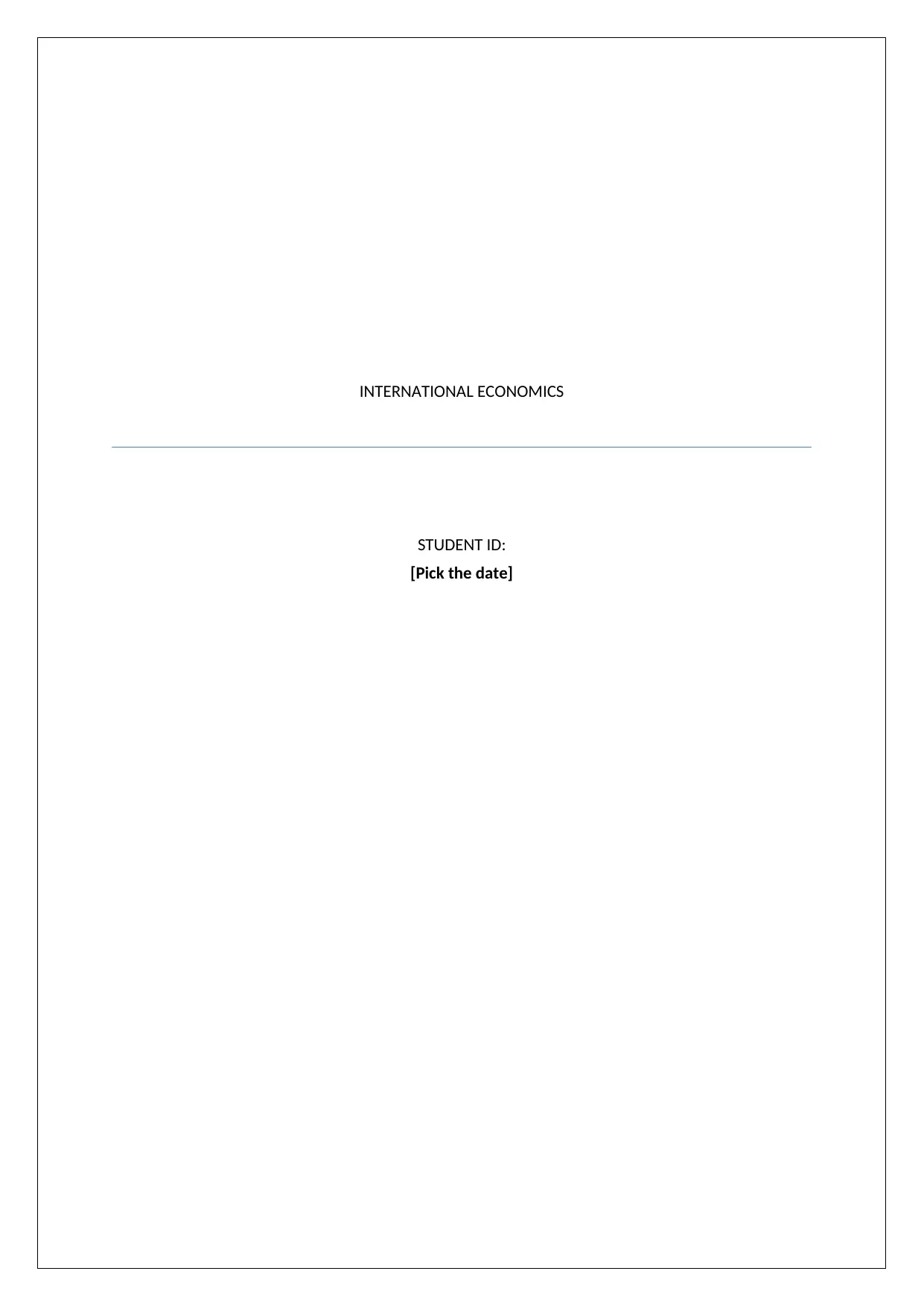
INTERNATIONAL ECONOMICS
STUDENT ID:
[Pick the date]
STUDENT ID:
[Pick the date]
Paraphrase This Document
Need a fresh take? Get an instant paraphrase of this document with our AI Paraphraser
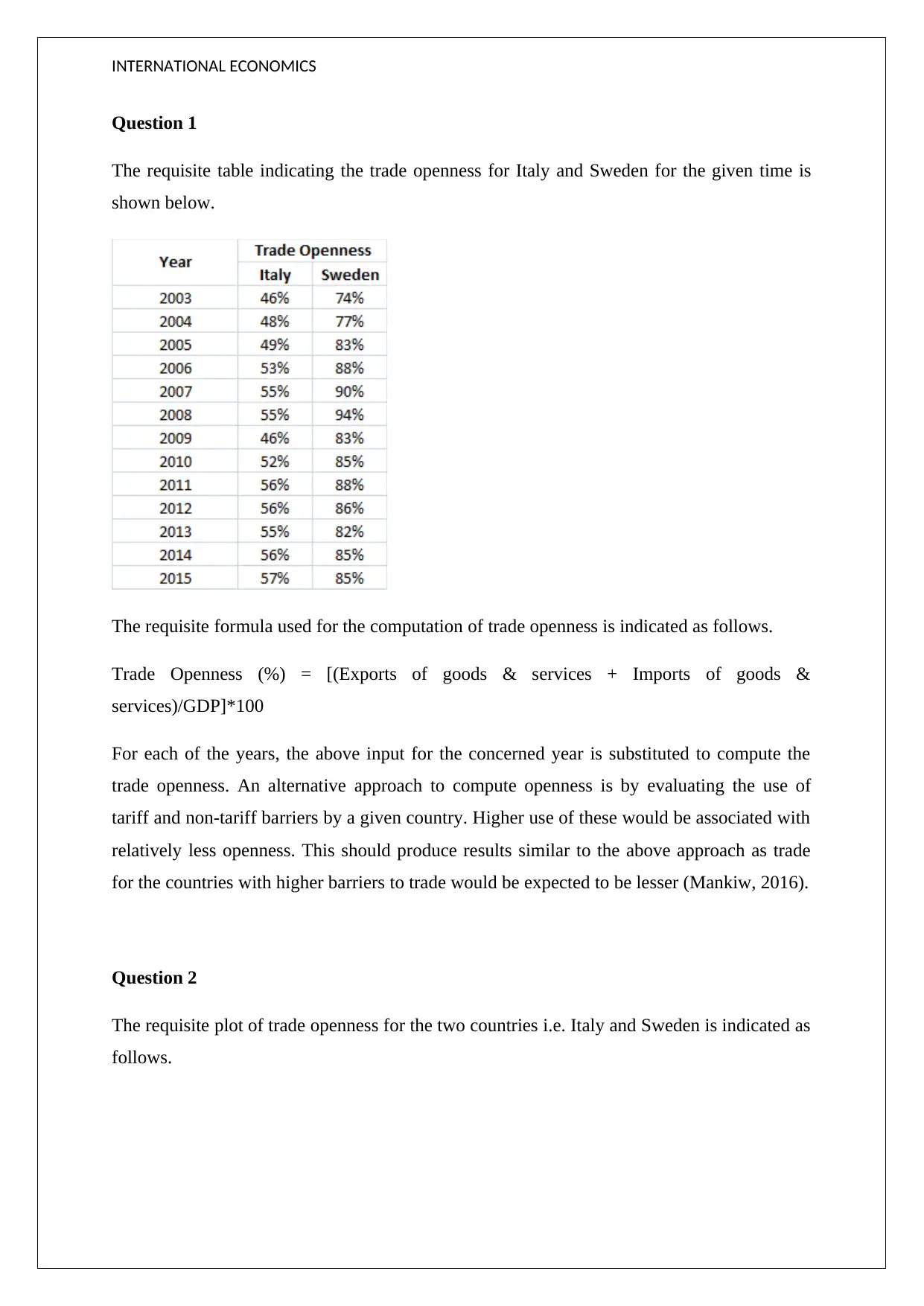
INTERNATIONAL ECONOMICS
Question 1
The requisite table indicating the trade openness for Italy and Sweden for the given time is
shown below.
The requisite formula used for the computation of trade openness is indicated as follows.
Trade Openness (%) = [(Exports of goods & services + Imports of goods &
services)/GDP]*100
For each of the years, the above input for the concerned year is substituted to compute the
trade openness. An alternative approach to compute openness is by evaluating the use of
tariff and non-tariff barriers by a given country. Higher use of these would be associated with
relatively less openness. This should produce results similar to the above approach as trade
for the countries with higher barriers to trade would be expected to be lesser (Mankiw, 2016).
Question 2
The requisite plot of trade openness for the two countries i.e. Italy and Sweden is indicated as
follows.
Question 1
The requisite table indicating the trade openness for Italy and Sweden for the given time is
shown below.
The requisite formula used for the computation of trade openness is indicated as follows.
Trade Openness (%) = [(Exports of goods & services + Imports of goods &
services)/GDP]*100
For each of the years, the above input for the concerned year is substituted to compute the
trade openness. An alternative approach to compute openness is by evaluating the use of
tariff and non-tariff barriers by a given country. Higher use of these would be associated with
relatively less openness. This should produce results similar to the above approach as trade
for the countries with higher barriers to trade would be expected to be lesser (Mankiw, 2016).
Question 2
The requisite plot of trade openness for the two countries i.e. Italy and Sweden is indicated as
follows.
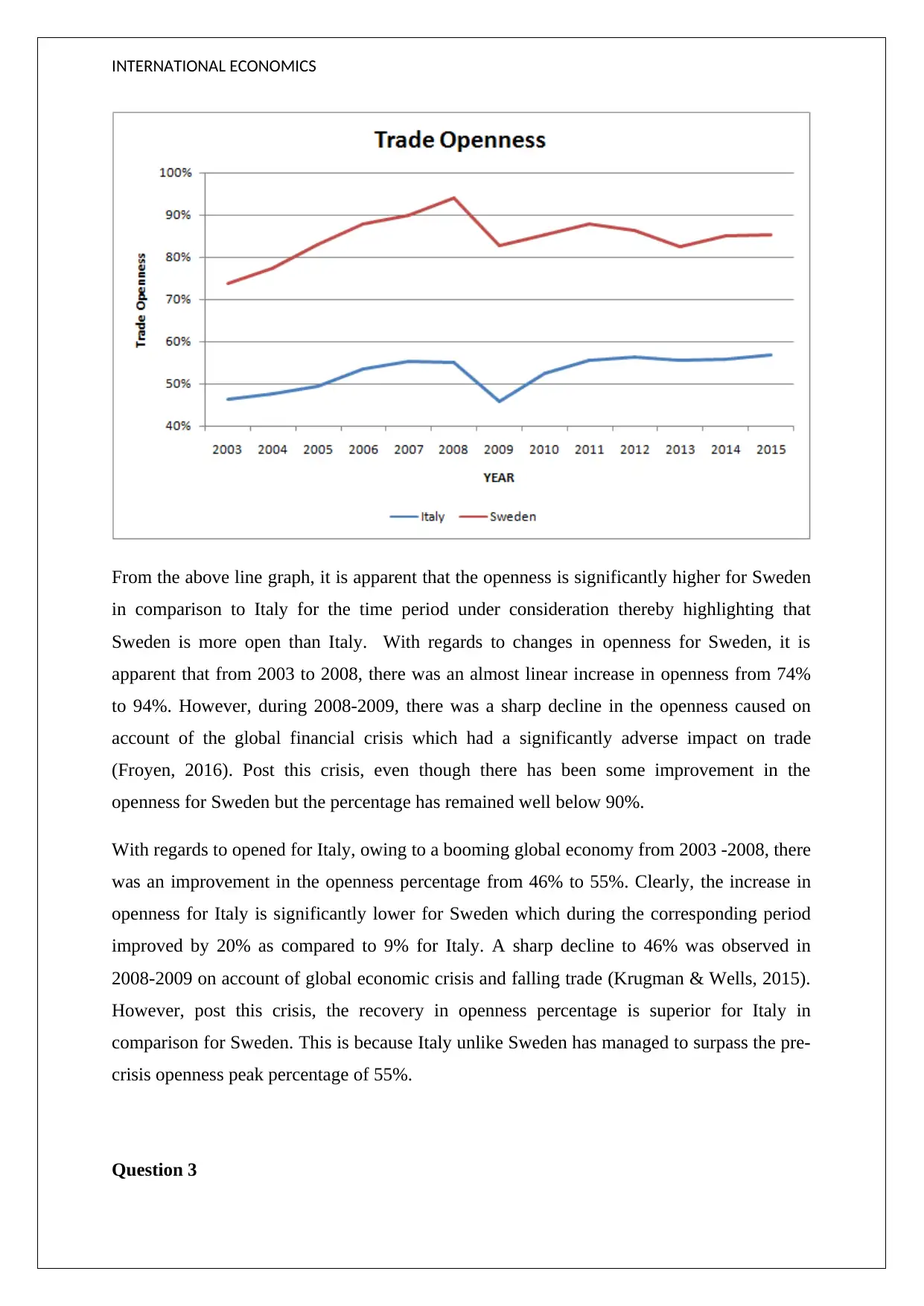
INTERNATIONAL ECONOMICS
From the above line graph, it is apparent that the openness is significantly higher for Sweden
in comparison to Italy for the time period under consideration thereby highlighting that
Sweden is more open than Italy. With regards to changes in openness for Sweden, it is
apparent that from 2003 to 2008, there was an almost linear increase in openness from 74%
to 94%. However, during 2008-2009, there was a sharp decline in the openness caused on
account of the global financial crisis which had a significantly adverse impact on trade
(Froyen, 2016). Post this crisis, even though there has been some improvement in the
openness for Sweden but the percentage has remained well below 90%.
With regards to opened for Italy, owing to a booming global economy from 2003 -2008, there
was an improvement in the openness percentage from 46% to 55%. Clearly, the increase in
openness for Italy is significantly lower for Sweden which during the corresponding period
improved by 20% as compared to 9% for Italy. A sharp decline to 46% was observed in
2008-2009 on account of global economic crisis and falling trade (Krugman & Wells, 2015).
However, post this crisis, the recovery in openness percentage is superior for Italy in
comparison for Sweden. This is because Italy unlike Sweden has managed to surpass the pre-
crisis openness peak percentage of 55%.
Question 3
From the above line graph, it is apparent that the openness is significantly higher for Sweden
in comparison to Italy for the time period under consideration thereby highlighting that
Sweden is more open than Italy. With regards to changes in openness for Sweden, it is
apparent that from 2003 to 2008, there was an almost linear increase in openness from 74%
to 94%. However, during 2008-2009, there was a sharp decline in the openness caused on
account of the global financial crisis which had a significantly adverse impact on trade
(Froyen, 2016). Post this crisis, even though there has been some improvement in the
openness for Sweden but the percentage has remained well below 90%.
With regards to opened for Italy, owing to a booming global economy from 2003 -2008, there
was an improvement in the openness percentage from 46% to 55%. Clearly, the increase in
openness for Italy is significantly lower for Sweden which during the corresponding period
improved by 20% as compared to 9% for Italy. A sharp decline to 46% was observed in
2008-2009 on account of global economic crisis and falling trade (Krugman & Wells, 2015).
However, post this crisis, the recovery in openness percentage is superior for Italy in
comparison for Sweden. This is because Italy unlike Sweden has managed to surpass the pre-
crisis openness peak percentage of 55%.
Question 3
⊘ This is a preview!⊘
Do you want full access?
Subscribe today to unlock all pages.

Trusted by 1+ million students worldwide
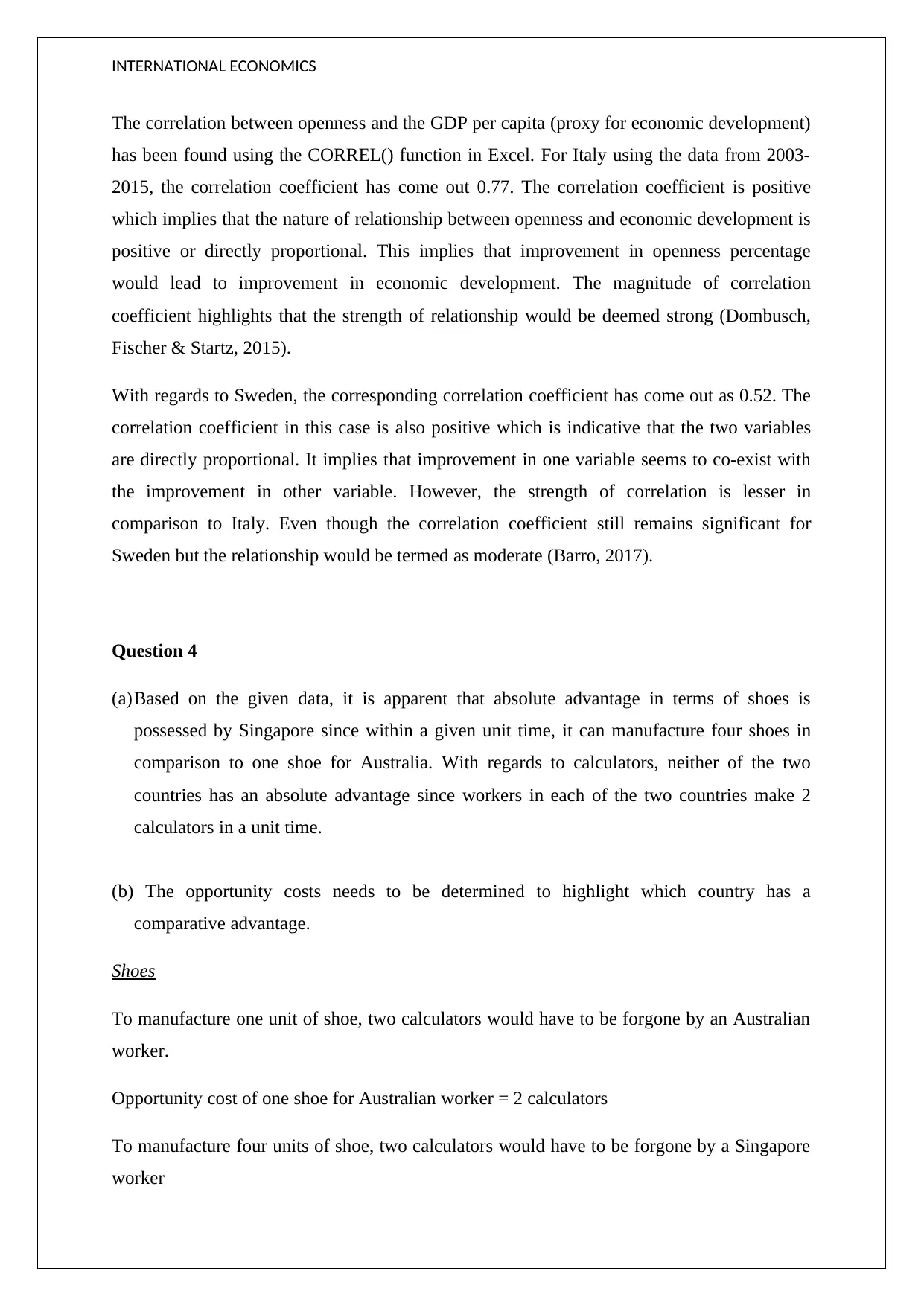
INTERNATIONAL ECONOMICS
The correlation between openness and the GDP per capita (proxy for economic development)
has been found using the CORREL() function in Excel. For Italy using the data from 2003-
2015, the correlation coefficient has come out 0.77. The correlation coefficient is positive
which implies that the nature of relationship between openness and economic development is
positive or directly proportional. This implies that improvement in openness percentage
would lead to improvement in economic development. The magnitude of correlation
coefficient highlights that the strength of relationship would be deemed strong (Dombusch,
Fischer & Startz, 2015).
With regards to Sweden, the corresponding correlation coefficient has come out as 0.52. The
correlation coefficient in this case is also positive which is indicative that the two variables
are directly proportional. It implies that improvement in one variable seems to co-exist with
the improvement in other variable. However, the strength of correlation is lesser in
comparison to Italy. Even though the correlation coefficient still remains significant for
Sweden but the relationship would be termed as moderate (Barro, 2017).
Question 4
(a)Based on the given data, it is apparent that absolute advantage in terms of shoes is
possessed by Singapore since within a given unit time, it can manufacture four shoes in
comparison to one shoe for Australia. With regards to calculators, neither of the two
countries has an absolute advantage since workers in each of the two countries make 2
calculators in a unit time.
(b) The opportunity costs needs to be determined to highlight which country has a
comparative advantage.
Shoes
To manufacture one unit of shoe, two calculators would have to be forgone by an Australian
worker.
Opportunity cost of one shoe for Australian worker = 2 calculators
To manufacture four units of shoe, two calculators would have to be forgone by a Singapore
worker
The correlation between openness and the GDP per capita (proxy for economic development)
has been found using the CORREL() function in Excel. For Italy using the data from 2003-
2015, the correlation coefficient has come out 0.77. The correlation coefficient is positive
which implies that the nature of relationship between openness and economic development is
positive or directly proportional. This implies that improvement in openness percentage
would lead to improvement in economic development. The magnitude of correlation
coefficient highlights that the strength of relationship would be deemed strong (Dombusch,
Fischer & Startz, 2015).
With regards to Sweden, the corresponding correlation coefficient has come out as 0.52. The
correlation coefficient in this case is also positive which is indicative that the two variables
are directly proportional. It implies that improvement in one variable seems to co-exist with
the improvement in other variable. However, the strength of correlation is lesser in
comparison to Italy. Even though the correlation coefficient still remains significant for
Sweden but the relationship would be termed as moderate (Barro, 2017).
Question 4
(a)Based on the given data, it is apparent that absolute advantage in terms of shoes is
possessed by Singapore since within a given unit time, it can manufacture four shoes in
comparison to one shoe for Australia. With regards to calculators, neither of the two
countries has an absolute advantage since workers in each of the two countries make 2
calculators in a unit time.
(b) The opportunity costs needs to be determined to highlight which country has a
comparative advantage.
Shoes
To manufacture one unit of shoe, two calculators would have to be forgone by an Australian
worker.
Opportunity cost of one shoe for Australian worker = 2 calculators
To manufacture four units of shoe, two calculators would have to be forgone by a Singapore
worker
Paraphrase This Document
Need a fresh take? Get an instant paraphrase of this document with our AI Paraphraser
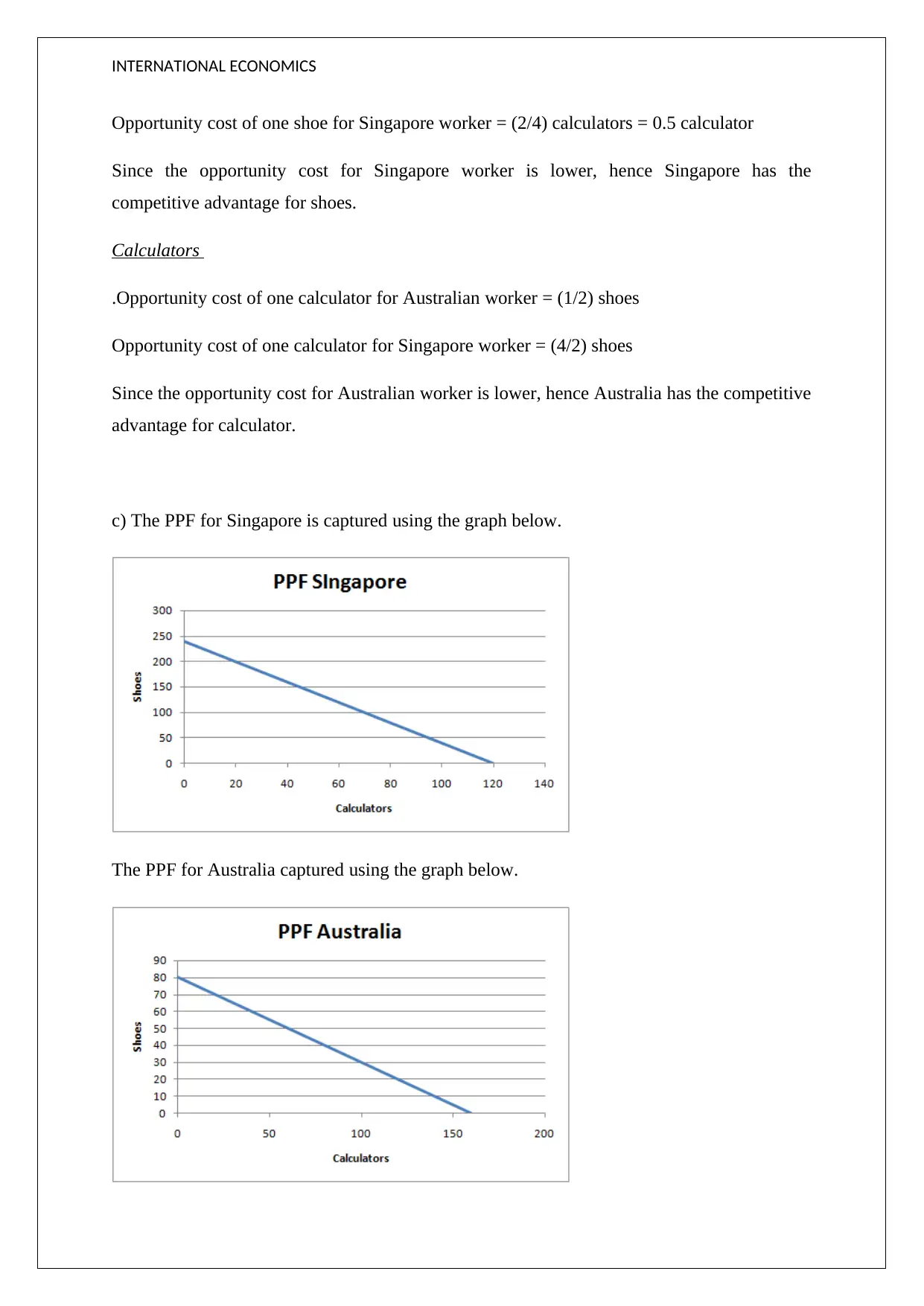
INTERNATIONAL ECONOMICS
Opportunity cost of one shoe for Singapore worker = (2/4) calculators = 0.5 calculator
Since the opportunity cost for Singapore worker is lower, hence Singapore has the
competitive advantage for shoes.
Calculators
.Opportunity cost of one calculator for Australian worker = (1/2) shoes
Opportunity cost of one calculator for Singapore worker = (4/2) shoes
Since the opportunity cost for Australian worker is lower, hence Australia has the competitive
advantage for calculator.
c) The PPF for Singapore is captured using the graph below.
The PPF for Australia captured using the graph below.
Opportunity cost of one shoe for Singapore worker = (2/4) calculators = 0.5 calculator
Since the opportunity cost for Singapore worker is lower, hence Singapore has the
competitive advantage for shoes.
Calculators
.Opportunity cost of one calculator for Australian worker = (1/2) shoes
Opportunity cost of one calculator for Singapore worker = (4/2) shoes
Since the opportunity cost for Australian worker is lower, hence Australia has the competitive
advantage for calculator.
c) The PPF for Singapore is captured using the graph below.
The PPF for Australia captured using the graph below.
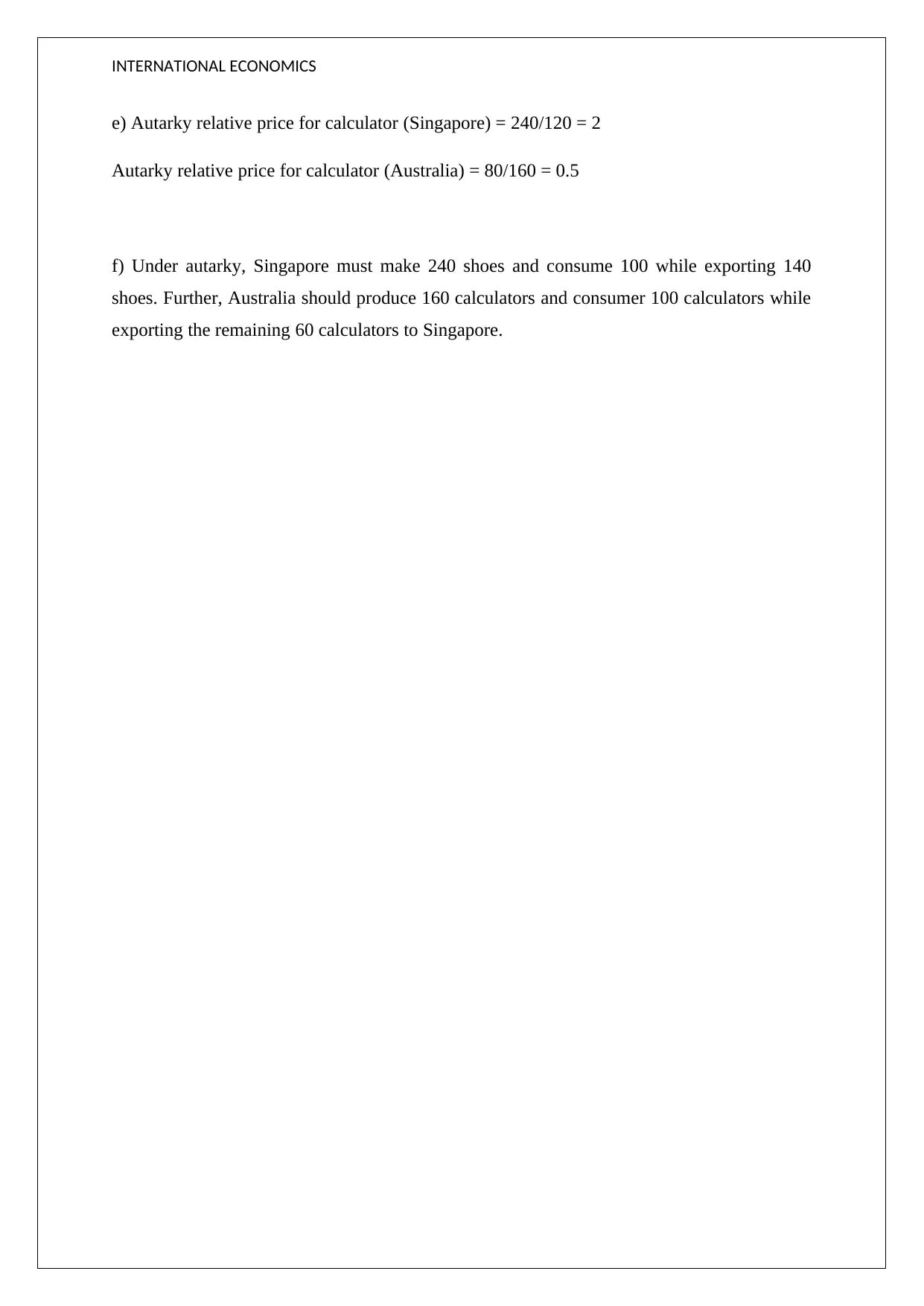
INTERNATIONAL ECONOMICS
e) Autarky relative price for calculator (Singapore) = 240/120 = 2
Autarky relative price for calculator (Australia) = 80/160 = 0.5
f) Under autarky, Singapore must make 240 shoes and consume 100 while exporting 140
shoes. Further, Australia should produce 160 calculators and consumer 100 calculators while
exporting the remaining 60 calculators to Singapore.
e) Autarky relative price for calculator (Singapore) = 240/120 = 2
Autarky relative price for calculator (Australia) = 80/160 = 0.5
f) Under autarky, Singapore must make 240 shoes and consume 100 while exporting 140
shoes. Further, Australia should produce 160 calculators and consumer 100 calculators while
exporting the remaining 60 calculators to Singapore.
⊘ This is a preview!⊘
Do you want full access?
Subscribe today to unlock all pages.

Trusted by 1+ million students worldwide

INTERNATIONAL ECONOMICS
References
Barro, R. (2017). Macroeconomics: A Modern Approach (4thed.). London: Cengage
Learning.
Dombusch, R., Fischer, S. & Startz, R. (2015).Macroeconomics (10thed.). New York:
McGraw Hill Publications.
Froyen, A. (2016), Macroeconomics (3rded.). New Delhi: Pearson Education.
Krugman, P. & Wells, R. (2015).Macroeconomics (3rd ed.). London: Worth Publishers.
Mankiw, G. (2016). Principles of Macroeconomics (6th ed.). London: Cengage Learning.
References
Barro, R. (2017). Macroeconomics: A Modern Approach (4thed.). London: Cengage
Learning.
Dombusch, R., Fischer, S. & Startz, R. (2015).Macroeconomics (10thed.). New York:
McGraw Hill Publications.
Froyen, A. (2016), Macroeconomics (3rded.). New Delhi: Pearson Education.
Krugman, P. & Wells, R. (2015).Macroeconomics (3rd ed.). London: Worth Publishers.
Mankiw, G. (2016). Principles of Macroeconomics (6th ed.). London: Cengage Learning.
1 out of 7
Related Documents
Your All-in-One AI-Powered Toolkit for Academic Success.
+13062052269
info@desklib.com
Available 24*7 on WhatsApp / Email
![[object Object]](/_next/static/media/star-bottom.7253800d.svg)
Unlock your academic potential
Copyright © 2020–2026 A2Z Services. All Rights Reserved. Developed and managed by ZUCOL.





